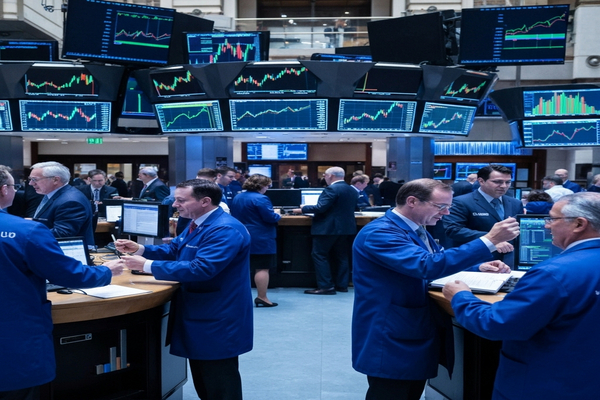
Markets rally on AI optimism and strong bank earnings. Global stocks held up as the AI boom and a string of bank results drove buying interest. Short term the mood is upbeat because fresh chip forecasts and large data center deals suggest near term demand for semiconductors and cloud capacity. Longer term the outlook is mixed because central bank moves and trade frictions could test valuations. The story matters for the US, Europe and Asia as tech hardware gains boost semiconductor exporters while safe havens like gold and the yen respond to policy and political noise. Compared with last quarter this feels more growth oriented and less defensive.
Market pulse: risk assets rally as earnings and AI headlines dominate
Strong corporate updates and a flurry of AI-related deals keep investors buying into stocks
World equity markets rose as investors focused on a string of upbeat corporate reports and renewed signs that the AI investment cycle is accelerating. U.S. banks reported results that beat expectations and supported financial stocks. Shares of Morgan Stanley (NYSE:MS) and Bank of America (NYSE:BAC) rose sharply after results and commentary that lifted confidence in bank earnings.
Tech hardware headlines supplied momentum. Dutch chip equipment maker ASML (NASDAQ:ASML) surprised on the upside. Taiwan Semiconductor Manufacturing Company (NYSE:TSM) then forecast fourth quarter revenue could rise by as much as 24 percent and said the AI megatrend is strengthening. Those comments reinforced a recent wave of large deals between AI firms and chipmakers.
Deal flow included major agreements linking cloud scale and chip makers and a consortium led by BlackRock (NYSE:BLK), Microsoft (NASDAQ:MSFT) and Nvidia (NASDAQ:NVDA) that agreed to buy a large data centre operator in a roughly $40 billion deal. At the same time OpenAI has been reported to strike work deals with Nvidia, Advanced Micro Devices (NASDAQ:AMD) and Broadcom (NASDAQ:AVGO) to expand data centre capacity. Together these moves are reshaping demand for semiconductors and data centre services now and into the next several quarters.
Policy signals and market reaction: dovish Fed talk, QT questions and flow into gold
Fed comments suggest easier policy; banks and money markets show a different picture
Federal Reserve comments this week pushed markets toward pricing interest rate cuts by year end. Fed Chair remarks that highlighted a softer labour market and the possibility of ending quantitative tightening earlier than planned drove traders to lower rate expectations. That is helping risk assets by reducing the near term cost of capital. The central bank stance matters now because market pricing of cuts and balance sheet policy can materially alter bank reserves and liquidity conditions.
That said the banking system is sending mixed signals. Money market metrics and some senior bankers point to ample liquidity and rising froth in parts of the market. This divergence between Fed rhetoric and banking system indicators increases the chance that financial conditions loosen further, which could amplify equity gains even as it raises questions about valuation pressure in the medium term.
Safe haven flows were visible too. Gold continued to set record highs as traders balanced risk appetite with uncertainty over trade controls and geopolitical headlines. The dollar weakened overall even as the Bank of Japan’s hawkish notes helped the yen tighten on the session.
Geopolitics, trade and supply issues: rare earths, oil uncertainty and a stalled US-China row
Trade friction and commodity supply questions keep volatility potential high
Markets faced persistent trade friction between Washington and Beijing with few signs of a breakthrough. Chinese state media issued a rebuttal to U.S. calls on rare earth controls and both sides remain locked in a cycle of tit-for-tat measures. That keeps price risk for critical inputs on the table while companies reassess supply chains and sourcing decisions.
Energy markets added complexity. The International Energy Agency still points to a multi month supply glut, but missing crude volumes of about 1.5 million barrels per day have left traders uncertain about the timing and scale of any rebalancing. Meanwhile U.S. political headlines and court rulings on federal worker layoffs have trimmed the immediate payroll drag from the government shutdown but not removed the policy uncertainty that can influence domestic consumption and growth expectations.
What to watch in the session: earnings calendar, surveys and central bank commentary
Corporate reports and a run of central bank speakers could change market tone fast
Investors should track the U.S. corporate calendar and a set of economic and central bank events that could shift short term sentiment. Bank of New York Mellon (NYSE:BK), M&T Bank (NYSE:MTB), Travelers (NYSE:TRV), U.S. Bancorp (NYSE:USB) and Charles Schwab (NYSE:SCHW) are among firms reporting, with regional banks under particular scrutiny for loan growth and funding costs. Other names coming up include Interactive Brokers (NASDAQ:IBKR), Snap-On (NASDAQ:SNA), Marsh & McLennan (NYSE:MMC), CSX (NASDAQ:CSX) and KeyCorp (NYSE:KEY).
On the data front, the Philadelphia Fed business survey and the NAHB housing market gauge will offer fresh reads on activity that may either reinforce or contradict central bank messaging. A series of Fed and other central bank speakers, including comments from the Fed Board and the Bank of Canada governor, could prompt intra-day moves in rates and the dollar.
For regional markets the message differs. Europe benefitted from strong corporate news such as Nestle’s (SIX:NESN) better than expected results and workforce reductions that boosted its shares. In Asia, Japan’s currency and bond market reacted to political developments and hawkish central bank voices. China faces a weaker growth profile in the latest quarter and rising calls for stimulus if the slowdown deepens.
In short, the coming session will be shaped by the interaction of AI-driven corporate demand, earnings updates and a complex policy backdrop. That mix is producing momentum now while leaving scope for quick swings if central bank tone or trade policy moves change. Watch earnings, the Fed commentary and key surveys to assess whether the current risk appetite holds through the next weeks.












